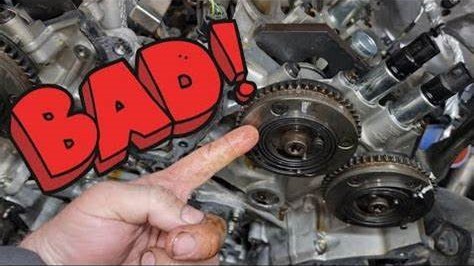Many Ford and Lincoln owners driving vehicles with the 3.5-liter EcoBoost engine worry about repair costs due to cam phaser failure. Cam phasers can wear at different rates, however, wear problems usually begin showing up around 50,000 miles and after.
How Cam Phasers Work
“The phasers typically advance valve timing at low RPM under load in order to give you more low-end torque and retard the timing for better top-end when the situation calls for it,” as reported by Joseph Coelho with help from contributor Steve Bassen in Ford F 150: How to Fix Cam Phasers. “The variable valve timing system operates when the engine computer (PCM) sends oil pressure to one or the other chamber of the phaser via cam timing solenoids."
The cam phaser is a “computer-operated sprocket that controls the camshaft operation,” explained by Road Sumo in Ford F-150 Cam Phaser – Symptoms and How to Replace. “By changing the position of the camshaft, the cam phaser effectively advances or delays the opening and closing of the valves (timing).” Ford actually began using variable-cam timing as early as 2004 in 4.6, 5.4 and 6.8-liter gas-powered trucks.
Cam Phaser Failure Symptoms
The main symptoms of bad cam phasers are reduced engine performance, a lit check engine light and rattling noises. According to reporter Magnus Sellen of Mechanic Base in 3 Signs of A Bad or Failing Cam Phaser, when the Powertrain Control Module (PCM) “gets a poor reading from the sensors, it’s going to turn on the check engine light.” If the valve timing isn’t optimized, performance issues will be exhibited. A knocking or rattling noise (like an old diesel idle) will occur if the cam phaser does not lock in position at base idle as designed.

The article, Ford Cam Phaser Problems – What You Need to Do Now at MyLemon.com reports that cam phaser failures can damage your vehicle’s VCT (Variable Control Timing) and ECU (Electronic Control Unit) because the VCT system no longer functions properly.
Many expert mechanics say you can still drive your vehicle if the cam phaser is malfunctioning. However, they also warn that owners risk damage to solenoids, the ECM and expensive engine repair. So, if you think your vehicle’s cam phaser is functioning improperly, have a certified mechanic at your Ford or Lincoln dealer check it as soon as possible.
Since the cam phaser is part of the powertrain, Ford and Lincoln Protect Extended Service Plans cover repairs associated with cam phaser failures. If you do not currently have a plan on your vehicle, it may be time to look into the benefits and features of PremiumCARE, ExtraCARE, BaseCARE and PowertrainCARE ESP Plans. You can review the coverages of these factory-backed Ford and Lincoln Protect Plans under the PLANS menu on our ZeiglerFordESP.com site. For additional information, you can call Zeigler Auto Group at 269.685.3557 to talk with an extended service plan expert.
Ford’s Commitment to Customer Satisfaction
For several years in the interest of customer satisfaction Ford has been providing extra service to customers with cam phaser problems. On March 2, 2021 the Ford Company instituted a Customer Satisfaction Program (21N03) to extend warranty coverage until January 1, 2023, for cam phasers that develop undesirable noise in vehicles equipped with a 3.5L gasoline turbo direct injection (GTDI) engine. Those vehicles include 2017-2020 Ford F-150 3.5-liter EcoBoost engines, 2018-2020 Expedition, 2018-2020 Navigator and the 2017-2020 F-150 Raptor/Limited variants.
Ford’s repair includes replacing all four Variable Camshaft Timing (VCT) units and free-of-charge reprogramming of the Powertrain Control Module (PCM). Ford also offered refunds on a prorated mileage basis for previously repaired cam phasers as part of the program. In search of improved fuel efficiency and performance, longer engine life and reduced engine noise, Ford has now developed updated cam phasers for the 3.5-liter engine.

In selecting an updated cam phaser, a FordMasterX.com article by Tarek and updated by David Jon, What Happens When Cam Phasers Go Bad? may help you avoid cam phaser problems.
Maintaining the recommended Ford and Lincoln maintenance on 3-valve motors can minimize cam phaser issues and excessive wear. Regular oil and filter changes at Ford’s recommended intervals will keep the seals and solenoids from developing leaks. Professional mechanics also suggest avoiding aggressive driving and practicing normal acceleration to extend engine life, even with updated cam phasers.
TImely pressure checks of the 3.5L engine oil pump and camshaft position sensors, as well as cleaning the solenoids, will help maximize cam phaser operation. Low oil pressure due to a faulty oil pump or too thin oil viscosity can result in poor lubrication, sludge build-up and increased cam phaser wear. A faulty ECU, responsible for optimizing cam function, will also result in a failing cam phaser.
For more information about 3.5L EcoBoost the refer to the feature Ford EcoBoost Engine Becomes PowerBoost Hybrid in 2021 F-150 on our website.
Protect Yourself from Expensive Repairs
The use of innovative technologies like cam phasers in 3.5L Ford EcoBoost engines makes it more important than ever to keep your expensive new or used Ford F-150 PowerBoost Hybrid truck or other Ford and Lincoln 3.5L EcoBoost engine vehicle running longer with a Ford Protect ESP warranty, including PremiumCARE, ExtraCARE, BaseCARE and PowertrainCARE. You may also want to consider getting a Premium Maintenance Plan for high-quality recommended maintenance of your gas engine vehicles.
Check with one of our Zeigler Factory Plans experts at 269.685.3557 who can prepare an instant quote for you using our Quick Quote Calculator. In addition, you can also obtain an extended service warranty quote and/or a maintenance plan quote by entering your vehicle information in the Custom Quote section in the right column of this page.
5-6-2024